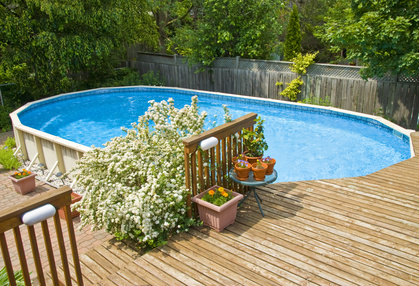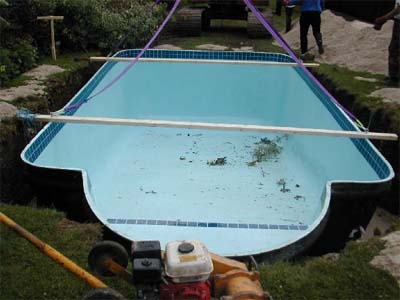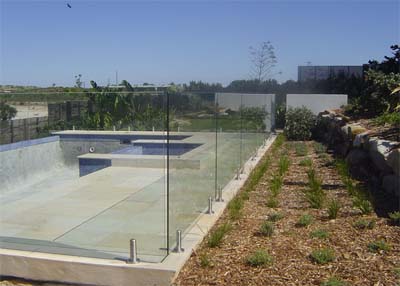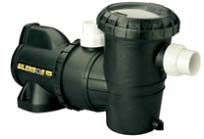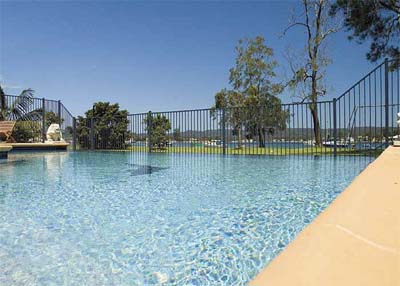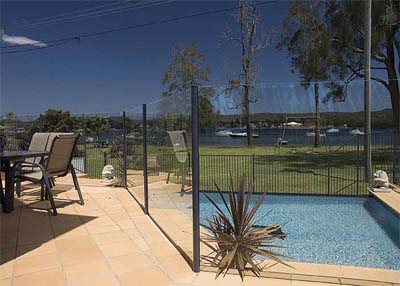Do you really want a swimming pool?
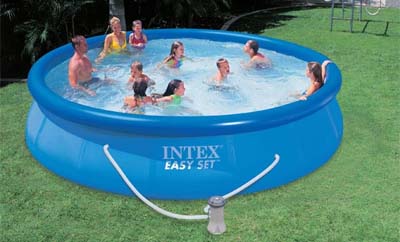
Stick to your budget. Your kids will have just as much fun in the low cost swimming pool shown above as in the custom inground pool shown below.
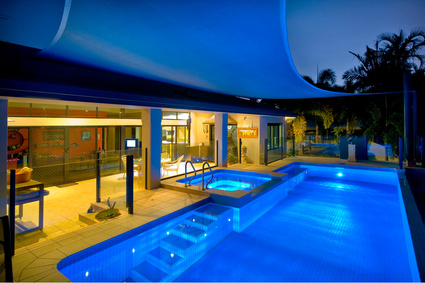
Do you want to provide endless hours of fun and exercise for your children in summer? Is there a need to escape the heat? Then you should consider getting a swimming pool.
However, because swimming pools are not cheap to build, buy or maintain, there are many factors to be considered before going any further.
Budget is a huge factor, but not the only consideration. Firstly, evaluate your reasons for installing a pool. Is it to be purely for recreation? Do you have a family member who has a health condition that would benefit from swimming? What space do you have for a pool, and what problems may this space present? Will the pool be used year round? What building codes apply in your area? What extras would you like with your pool: spa, waterfall, slides? How will your pool affect your landscaping, and what other things could you do with the space that a pool will use?
Choosing a pool
First of all, make sure you know your budget and stick to it. Be confident that you can afford the swimming pool that you choose, and that you have allowed for the extras that go with a pool. You won't have fun swimming if each time you do a lap you think of how much debt you are in!
Research the kind of pool you want, and why. Good planning will help you minimise extra expenditures. Give consideration as to how you would like the area around the pool landscaped and factor in that as an expense. Also give serious consideration to maintenance costs - pumps, filters and chemicals are regular expenses that need to be budgeted. Filling your pool will cause your water bill to rise significantly, unless you have water tanks installed. You will also want to account for the expense of water loss through normal usage of the pool. Water restrictions in times of drought may mean having to buy in water. And don't forget pool fencing - it's mandatory.
Types of pool
The material that your pool is built from will determine a lot of features about it, like the frequency of maintenance and how flexible it can be in terms of design.
The three types of swimming pool to choose from are:
1. Above ground pools
This type of pool is the cheapest to buy, the simplest to install and is easy to dismantle if you move, or grow tired of it. Above ground pools can be set up with decking and landscaping to look almost as good as more expensive in-ground pools.
Prices range from $3,000 to $8,000 for the pool, with landscaping, filtering, electrical equipment and decking extra. One advantage of an above ground pool is that they don't need to have concrete coping, which can add an extra $1200 (approximately). An above ground pool can be installed into a hole dug in the ground so that it resembles an in-ground pool. They have a steel frame and a vinyl liner. The frame should last approximately 25 years, depending on the local conditions, and the liner should last around 15 years before it needs replacing.
2. In-ground fibreglass pools
These are the second most affordable pool.
Prices for a fibreglass pool are around $20,000 - $25,000. This price is just for the pool to be placed in the ground, without filtration, electrical connections, landscaping or fencing. Fibreglass pools are manufactured off site in one piece, and then placed in an excavation on the site. Fibreglass is a durable and flexible material that can be made and shaped into a wide array of sizes and shapes. Fibreglass has a smooth surface and is algae-resistant.
3. Concrete pools
Concrete pools are often custom or semi-custom designs, and cost the most to build.
The cost of a concrete pool is varied by the interior finish of the pool. The cheapest finish is a pebble interior, followed by a glass bead interior, with tiling the most expensive option. Pebbles and glass finishes are plastered on, and then blasted off to expose a smooth, durable finish. Glass beads can come in any desired colour. Tiles are even more variable, but are the most expensive because they are labour intensive to apply.
Your budget for a concrete pool needs to be in excess of $50,000.
NOTE: Prices quoted above were researched in 2012.
Getting started with building your pool
Once you have made the decision on which pool is right for you, there are some steps you then need to take before you sign on the dotted line.
- Shop around for a contractor
- Obtain at least three written quotes
- Make certain that ALL labour and materials are included as well as building permits. A written list of inclusions and exclusions is a must.
- Ask for a list of previous customers and their phone numbers and call a few of them for a reference.
- Don't make a hasty decision. Take your time and don't be pressured into signing a contract.
- Check with the Department of Fair Trading (or the equivalent) in your state (if you are in Australia). You can do an online check of your swimming pool contractor on their website, and they also have a section on things to consider when building a pool. Well worth a visit. Here is a link to the NSW Fair Trading site: Building a Pool: Dept. of Fair Trading, NSW
- Never pay a contractor in cash. Always use a cheque, money order or credit card so you have proof of purchase.
- Investigate what limitations there are to your pool site. If it is close to the building it may need extra structural reinforcing. If the ground is sloping retaining walls may have to be built, and these all need extra care to ensure that they can take the extra strain that a pool will cause.
Solar energy systems for pools
When most people think of solar energy systems, they think of the large crystalline structures that are meant to collect solar energy to convert to solar power. However, there are other uses for solar energy systems. One of the more ingenious uses for this technology is the use of solar energy systems for heating pools. By using solar power to heat your swimming pool you can be sure that your morning swim will always be pleasant, less taxing on the environment and affordable.
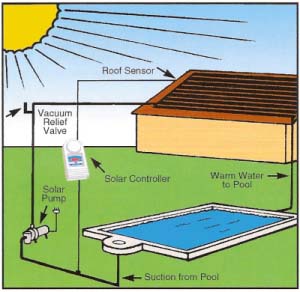
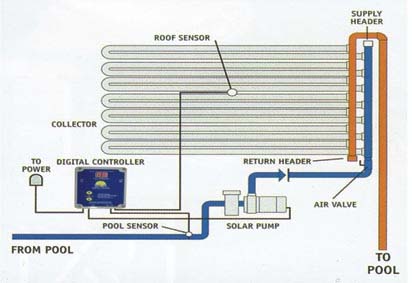
How solar heating works. Images supplied by:
Direct Pools
&
Supreme Heating.
Unless you live in a tropical climate where the temperature doesn't drop at night you will need to heat your pool to make it comfortable for year-round swimming. Most people simply to purchase a pool cover, but pool covers only work to limit heat loss they do not heat the water. Gas heaters work well, but the operating costs of a gas heater can really add up. A low initial cost can draw pool owners to gas heating, but the costs over the life of the use of the pool can be large, and will only get larger as energy supplies diminish.
Using a solar energy systems for heating your pool can solve all of the problems mentioned above. Usually, solar energy systems are installed on the roof of your house, where there is the sunlight. Solar energy systems collect heat, which is transmitted to water stored in hoses behind the solar collectors. This warms the water, which is then circulated through the pool. This method of pool heating does cost more, initially, than other heating system, but the solar collectors and other accessories pay for themselves in a few years. If you plan to live in the house for some time, the cost will be a fraction of any other heating system. If you plan to sell the house in the near future, the solar energy system will add to the value of the house since they are considered energy savers over time.
The use of solar energy systems for heating pools is a time tested strategy. If you live in an area where lots of homes you may notice a few homes with pools that have solar energy systems. The only downside to this approach is that the government does not offer any financial incentives for heating your pool with solar. However, given the savings, it really doesn't matter.
Swimming pool sanitation
Sanitation involves filtration to remove pollutants, disinfestation to kill infectious organisms, good hygiene to lessen the introduction of contaminants to the pool water, and regular testing and adjusting of PH levels, alkalinity and calcium levels.
The World Health Organisation has published international guidelines for the safety of swimming pools, including standards for minimising microbial and chemical hazards.
There are basically three different types of filters: sand, diatomaceous earth and cartridge filters. A filter is placed in-line immediately after the water pump. A well maintained filtration system is the first barrier in combatting contaminants. Preventing the entry of pool contaminants, both pathogenic and non-pathogenic, into the pool water is impossible, therefore effective treatments for sanitising the pool water is needed.
Chlorinating a pool is still the most widely used method of sanitising water. It does an excellent job, because it attacks anything organic. Because of this, it can be irritating to eyes, skin and hair. Optimum chemical levels should be maintained to adequately disinfect the water.
Salt water pools are not chlorine free pools. A salt water pool is one that utilises a chlorine generator. This produces chlorine from salt; i.e., sodium chloride. Water passes over the chlorine generator producing chlorine which is straight away converted into hypochlorous acid, which is the active sanitiser that kills algae, bacteria and fungi. The advantage of salt water pools is that chlorine does not have to be manually added to the pool, thus the owner does not have to buy, store or handle it. A disadvantage is that they consume a lot of electricity to run the system. Another is that the generator chamber has a limited life due to the corrosive nature of chlorine.
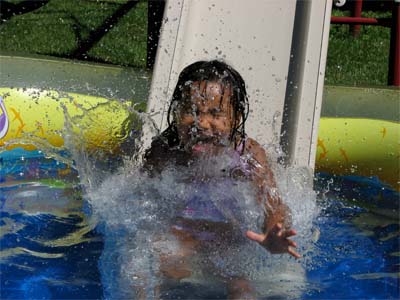
Make your pool more fun for your kids -
get some fun extras
Equipment housing
Most swimming pool constructions incorporate a housing for the filtration equipment. This protects the equipment from the sun and rain, and it reduces the noise from the running filter. There are regulations in place to protect neighbours from the noise generated by pool equipment.
Extras for your pool
Extra features that can be added to pools are artificial streams and waterfalls, fountains, water slides, artificial pebble beaches, submerged seating, plunge pools, spas and hot tubs and shallow children wading pools.
A good landscaper can integrate the pool with the surroundings to expand the recreational opportunities associated with a pool. Outdoor BBQ areas and kitchens, shade areas, gazebos, garden furniture and inbuilt seating structures are all possibilities to expand your outdoor area.
Swimming pool safety guidelines
Fencing requirements
When building a pool. It is necessary to:
- Install temporary fencing around the pool area while it is under construction
- Inform your local council about where your permanent pool fence is going to be located, to make sure that its location meets council guidelines
- Arrange a final inspection by your local council or private building certifier as soon as possible after the permanent compliant fence has been installed
After the pool is built, the owner should ensure:
- The pool is surrounded on all sides, at all times, by a child-resistant fence separating the pool from the house and any adjoining premises
- All doors and gates providing access to the pool must be kept closed at all times
- A warning sign must be displayed near the pool
Child safety
- If a child is missing, check the water first
- Always watch children when they are in or near the water
- Learn adult and infant CPR, and have an approved CPR chart in the pool area, these can be obtained from your local council, pool shop or community organisations such as St Johns Ambulance, Australian Red Cross or the Royal Life Saving Association
- At outdoor gatherings, designate an adult to be responsible for supervising children
- Ensure the pool gate is always closed and never propped or left open.
- Keep trees, shrubs, pot plants and furniture away from the pool fence so that kids can’t use them to climb in
Electrical safety
Pools and electricity can be a lethal combination. Be very careful if you have a swimming pool that has a portable electrical pump and filter system where there is no protective housing. When buying pool with electrical pumps and filters you should
- Make sure the pump and filter have an electrical safety approval number or Regulatory Compliance mark.
- Check that they are suitable for outdoor use
- Fit a safety switch to the house where the pool will be used
- Arrange for a licensed electrician to install a suitable weather protected electrical power point close to where the pool equipment will be located

